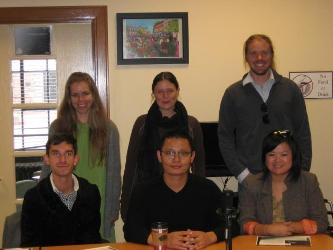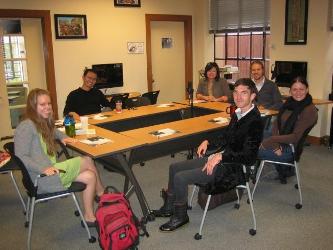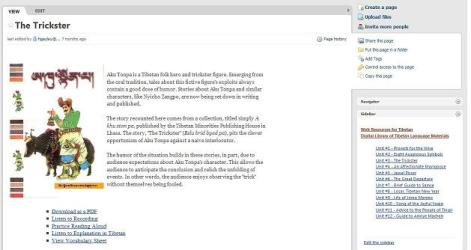|
Page 3 of 3
Instruction in less commonly taught languages is one of the challenges in a stand-alone Master’s program. In a PhD program there may be advanced graduate students available to teach introductory-level language classes when there is no funding for a full-time instructor. For a stand-alone Masters program, however, this gap typically gets filled through faculty overload. In our religious studies department, our Hinduism professor, Loriliai Biernacki, had to offer introductory Sanskrit as an overload for several years until she created a consortium agreement with neighboring Naropa University. When I joined the faculty as the Buddhism professor in 2008, this agreement was already in place, so my students have been able to take first- and second-year Tibetan as well as Sanskrit at Naropa. But there is still a gap in their education since the Naropa class emphasizes classical Tibetan with minimal instruction in the colloquial language.
 To fill this gap in an affordable way, the Tibetan class that I have described is run as an instance of Directed Independent Language Study (DILS). Inaugurated at Yale University, DILS is an innovative program to promote the study of less commonly taught languages, in which a small number of students are matched with a native speaker. Mark Knowles, the current director of the Anderson Language and Technology Center (ALTEC) at the University of Colorado, Boulder, has been a strong advocate of DILS — having come to ALTEC from Yale — and has supported Tibetan as one of the pilot languages in the program. Each instance of DILS costs approximately $2,500, which covers administrative and instructional costs for a semester. On such a shoestring budget, we have been able to offer DILS at the University of Colorado, Boulder, since 2009 with funding from three departments: anthropology, geography, and religious studies. I supervise the program, arranging the readings and attending class. It takes about the same time as an independent study, but nothing as onerous as teaching an overload course. To fill this gap in an affordable way, the Tibetan class that I have described is run as an instance of Directed Independent Language Study (DILS). Inaugurated at Yale University, DILS is an innovative program to promote the study of less commonly taught languages, in which a small number of students are matched with a native speaker. Mark Knowles, the current director of the Anderson Language and Technology Center (ALTEC) at the University of Colorado, Boulder, has been a strong advocate of DILS — having come to ALTEC from Yale — and has supported Tibetan as one of the pilot languages in the program. Each instance of DILS costs approximately $2,500, which covers administrative and instructional costs for a semester. On such a shoestring budget, we have been able to offer DILS at the University of Colorado, Boulder, since 2009 with funding from three departments: anthropology, geography, and religious studies. I supervise the program, arranging the readings and attending class. It takes about the same time as an independent study, but nothing as onerous as teaching an overload course.
 I still do private readings with students in order to prepare them for their Masters thesis. After two years of classical Tibetan, students are simply not yet capable of translating on their own. What results is an “assisted translation,” one in which the students receive considerable help to reach a polished translation. Nonetheless, the process allows them to experience what it takes to translate a text (or passage of a text) from beginning to end. This is a key step toward demonstrating their proficiency — not to mention grit and determination — in order to continue on to a PhD program. I still do private readings with students in order to prepare them for their Masters thesis. After two years of classical Tibetan, students are simply not yet capable of translating on their own. What results is an “assisted translation,” one in which the students receive considerable help to reach a polished translation. Nonetheless, the process allows them to experience what it takes to translate a text (or passage of a text) from beginning to end. This is a key step toward demonstrating their proficiency — not to mention grit and determination — in order to continue on to a PhD program.
The upshot is that after a year of DILS, supplemented by a modest amount of additional study on their own or through Naropa University, graduate students can qualify for a second-year colloquial language intensive over the summer. So far my students have favored the popular summer program at the Rangjung Yeshe Institute in Kathmandu, since they can also experience a cultural immersion, live with a Tibetan family, and begin developing contacts in their area of research. Only by qualifying for a second-year modern language program can students apply for a FLAS, or Foreign Language and Area Studies fellowship, so in this way DILS provides another bridge for graduate language study.
 As a supplement to other language study (coursework at other institutions, summer programs, and private readings), DILS can be extremely useful for a stand-alone Masters program in which students need to develop conversational skills in less commonly taught languages. And it can be especially effective with faculty input into the curriculum, based on the students’ needs in relation to the language in question. Of course it also depends on having native speakers available in the area. We are fortunate in Boulder to have a plethora of native Tibetan speakers and a handful of qualified language instructors. For those who are not so fortunate, an online format can serve as an alternative. At this point DILS Tibetan at the University of Colorado, Boulder, is a work in progress and only runs so long as we have sufficient student interest. In the meantime, we are developing a digital library of readings and recordings, based on Tibetan Storytime, that we hope to make available to the wider public at some point in the future. As a supplement to other language study (coursework at other institutions, summer programs, and private readings), DILS can be extremely useful for a stand-alone Masters program in which students need to develop conversational skills in less commonly taught languages. And it can be especially effective with faculty input into the curriculum, based on the students’ needs in relation to the language in question. Of course it also depends on having native speakers available in the area. We are fortunate in Boulder to have a plethora of native Tibetan speakers and a handful of qualified language instructors. For those who are not so fortunate, an online format can serve as an alternative. At this point DILS Tibetan at the University of Colorado, Boulder, is a work in progress and only runs so long as we have sufficient student interest. In the meantime, we are developing a digital library of readings and recordings, based on Tibetan Storytime, that we hope to make available to the wider public at some point in the future.
|
![PDF-NOTE: Internet Explorer Users, right click the PDF Icon and choose [save target as] if you are experiencing problems with clicking.](http://rsnonline.org/templates/rsntemplate-smallmasthead/images/pdf_button.png)



 To fill this gap in an affordable way, the Tibetan class that I have described is run as an instance of Directed Independent Language Study (DILS). Inaugurated at Yale University, DILS is an innovative program to promote the study of less commonly taught languages, in which a small number of students are matched with a native speaker. Mark Knowles, the current director of the Anderson Language and Technology Center (ALTEC) at the University of Colorado, Boulder, has been a strong advocate of DILS — having come to ALTEC from Yale — and has supported Tibetan as one of the pilot languages in the program. Each instance of DILS costs approximately $2,500, which covers administrative and instructional costs for a semester. On such a shoestring budget, we have been able to offer DILS at the University of Colorado, Boulder, since 2009 with funding from three departments: anthropology, geography, and religious studies. I supervise the program, arranging the readings and attending class. It takes about the same time as an independent study, but nothing as onerous as teaching an overload course.
To fill this gap in an affordable way, the Tibetan class that I have described is run as an instance of Directed Independent Language Study (DILS). Inaugurated at Yale University, DILS is an innovative program to promote the study of less commonly taught languages, in which a small number of students are matched with a native speaker. Mark Knowles, the current director of the Anderson Language and Technology Center (ALTEC) at the University of Colorado, Boulder, has been a strong advocate of DILS — having come to ALTEC from Yale — and has supported Tibetan as one of the pilot languages in the program. Each instance of DILS costs approximately $2,500, which covers administrative and instructional costs for a semester. On such a shoestring budget, we have been able to offer DILS at the University of Colorado, Boulder, since 2009 with funding from three departments: anthropology, geography, and religious studies. I supervise the program, arranging the readings and attending class. It takes about the same time as an independent study, but nothing as onerous as teaching an overload course. I still do private readings with students in order to prepare them for their Masters thesis. After two years of classical Tibetan, students are simply not yet capable of translating on their own. What results is an “assisted translation,” one in which the students receive considerable help to reach a polished translation. Nonetheless, the process allows them to experience what it takes to translate a text (or passage of a text) from beginning to end. This is a key step toward demonstrating their proficiency — not to mention grit and determination — in order to continue on to a PhD program.
I still do private readings with students in order to prepare them for their Masters thesis. After two years of classical Tibetan, students are simply not yet capable of translating on their own. What results is an “assisted translation,” one in which the students receive considerable help to reach a polished translation. Nonetheless, the process allows them to experience what it takes to translate a text (or passage of a text) from beginning to end. This is a key step toward demonstrating their proficiency — not to mention grit and determination — in order to continue on to a PhD program. As a supplement to other language study (coursework at other institutions, summer programs, and private readings), DILS can be extremely useful for a stand-alone Masters program in which students need to develop conversational skills in less commonly taught languages. And it can be especially effective with faculty input into the curriculum, based on the students’ needs in relation to the language in question. Of course it also depends on having native speakers available in the area. We are fortunate in Boulder to have a plethora of native Tibetan speakers and a handful of qualified language instructors. For those who are not so fortunate, an online format can serve as an alternative. At this point DILS Tibetan at the University of Colorado, Boulder, is a work in progress and only runs so long as we have sufficient student interest. In the meantime, we are developing a digital library of readings and recordings, based on Tibetan Storytime, that we hope to make available to the wider public at some point in the future.
As a supplement to other language study (coursework at other institutions, summer programs, and private readings), DILS can be extremely useful for a stand-alone Masters program in which students need to develop conversational skills in less commonly taught languages. And it can be especially effective with faculty input into the curriculum, based on the students’ needs in relation to the language in question. Of course it also depends on having native speakers available in the area. We are fortunate in Boulder to have a plethora of native Tibetan speakers and a handful of qualified language instructors. For those who are not so fortunate, an online format can serve as an alternative. At this point DILS Tibetan at the University of Colorado, Boulder, is a work in progress and only runs so long as we have sufficient student interest. In the meantime, we are developing a digital library of readings and recordings, based on Tibetan Storytime, that we hope to make available to the wider public at some point in the future.